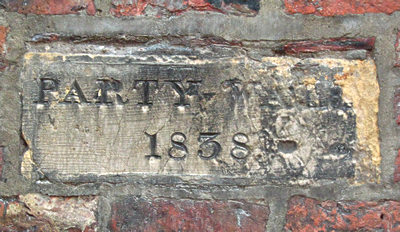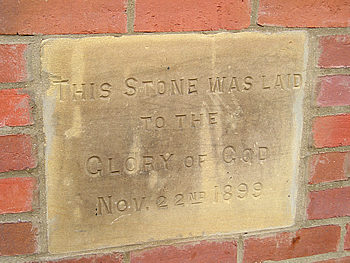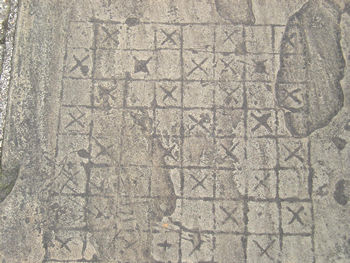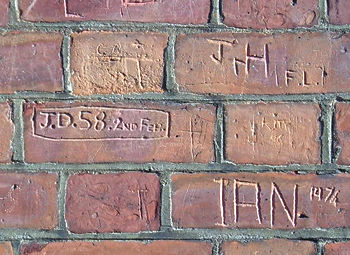July 2008
On my wanders I’ve noticed various odd little inscriptions and markers that make no sense now, though I guess they once did, and maybe still do to those in the know. Here’s a small random collection noticed on York’s streets.

It looks like it says “Party 1838″. Some party that was, commemorated in stone. Only joking, it does of course read “Party Wall 1838″. Though that makes it no clearer really. There are party walls all over the place and most of them don’t have a carved stone marker. So why this one has one is a mystery. And I’m glad about that. Too many things around here have acquired explanatory signs.
The stone is in the wall on the corner of St Maurice’s Road, opposite the Monk Bar Hotel. I only noticed it recently, though I must have walked past it many times.

This stone can be found in the middle of a brick wall on Skeldergate. The stone states that “This stone was laid to the glory of God Nov 22nd 1899″. The current building, whose wall the stone is set in, is modern and bears no relationship to the buildings that were here before, which unfortunately I don’t remember.
There was, on this street, the Skeldergate Mission Hall, opened in 1900 – I imagine this must be a foundation stone from that place of worship.
It’s a nice touch, even in the eyes of this particular agnostic, that the stone was obviously saved and re-set in this modern brick wall when the site was redeveloped.
There are of course other foundation stones in “nonconformist” chapels elsewhere in the city – as noted in the 2004 wanders – for example Salvation Army citadel (still used by the Salvation Army) and York Central Mission (now a restaurant).

This isn’t on a wall, but underfoot, and was noticed during a wander along the city walls. Whereas the other examples were obviously professionally carved into stone, to mark place and boundary, this carving into stone seems random. It’s in the section between Victoria Bar (off Nunnery Lane) and Skeldergate Postern. It’s just there in the stone walkway along the walls, a square grid full of crosses. I’ve got no idea of its meaning, or indeed if it has any meaning at all.
Update – Aug 2010
Thanks to Blazej who suggested that the carving above is a chess board, and to Richard, who recently sent me the following explanation: ‘I met a man who had made a lifetime’s passion out of studying and researching the walls. He told me that many parts of the city walls were in a bad state of repair in Victorian times and when the York Prison (formerly on the site around Clifford’s Tower) was demolished much of the building material was recycled into repairing the walls. It is likely that the grid was originally on the floor of a cell, carved there by its occupants so they could play draughts or chess. Notice that the prisoner made a mistake in the second row down, carving a cross (a black square) where there shouldn’t be one!’

This is the brick wall of the old chapel building on Wilton Rise, off Holgate Road. It was originally built as a Methodist misssion chapel in 1872, later used by the Salvation Army (from the 1930s) and in more recent times has been the York Spiritualist Centre.
Carved into its brick wall at the front are various names and initials, including “IAN” who apparently carved his name in 1974. Another is J.D – it’s not clear if the ’58’ suggests a year, but J.D was scraping away at the brick on 2nd Feb, in whatever year it was.
Again it reminded me of the Central Mission Hall, mentioned above. In that building, bricks show the initials of those who contributed financially to the building of the chapel, and they were stamped into the brick. In the case of this old chapel building, I don’t know why so many people laboriously carved their names and initials in the brick – presumably just what we call graffiti, but in this case created before the age of the spray can.
It’s valued as another random discovery, a little real and authentic thing. Odd little carved stones, names scraped into brick, hand painted signs on old weathered buildings, these things become more important, in a town increasingly geared towards tourism, labelled and tidied and somehow losing some of its soul.





Thank you for adding a comment. Please note that comments are moderated, but should appear within 24 hours.